The midfielder strides forward ball at feet, he looks up for options, no teammates are making themselves available. He beats one opponent and attempts a slide rule pass into space but the striker doesn't anticipate it and the ball runs harmlessly into touch. The crowd sighs - there he goes again, he seems to have all the skill in the world but no end product.
But what happens if this skilled player moves to a club with better quality teammates? Does he have more passing options? Are his dangerous through balls anticipated by better quality strikers?
What happens if you take the best player from a midtable team and put them in a great team?
Or, conversely, what happens if you put a single player from a great team into an average side? Does he raise the level of his teammates or does he get dragged down to the level of his new side?
And where is the tipping point? If you slowly added Aston Villa players into the Barcelona team when would they start to resemble Aston Villa more than Barcelona? They could probably take Jack Grealish in place of one of their midfield three and still be good. Maybe even Tammy Abraham as one of the front 3. But when you start swapping out Rakitic for Whelan and Messi for Kodjia you aren’t going to be playing like Barcelona anymore.
So can we test what happens when players move from great teams to average teams and vice versa?
Yes, by examining the impact on player outputs when they move between different level clubs.
To do this I have selected 22 players who transferred between clubs in the summer 2018 transfer window. For each player, I looked at the relative league position of the team they left (when they left it) and the team they joined. Moving from a midtable team to a Champions League regular would be seen as moving up a level. From midtable or higher, to a relegation fighting team would be moving down a level.
We will also look at players from relegated teams to see if moving down a league makes your outputs increase as you come up against lower level players.
It is relatively easy to find players who have moved to clubs of a similar level. As you might expect there are fewer examples of players who played for a high-level club a lot in 2017/18 and moved to a lower level team for the 2018/19 season.
Because it is believed that attacking output is less dependent on the team's style of play than defensive output (for example we would expect Burnley defenders to make more clearances than Manchester City defenders) I am looking mainly at midfielders and forward players.
The players selected are:
Giovani Lo Celso from PSG to Betis = Down a level
Andre Gomes from Barcelona to Everton = Down a level
Yuri Berchiche from PSG to Bilbao = Down a level
Victor Camarasa from Betis to Cardiff = Down a level
Cheickou Kouyate from West Ham to Crystal Palace = Same level
Ki Sung-yeung from Swansea to Newcastle = Same level
Richarlison from Watford to Everton = Same level
Gerard Moreno from Espanyol to Villareal = Same level
Kevin Gamiero from Athletico to Valencia = Same level
Sergio Canales from Real Sociedad to Betis = Same level
Daniel Wass from Celta Vigo to Betis = Same level
David Junca from Eibar to Celta Vigo = Same level
Ibrahim Amadou from Lille to Sevilla = Same level
Steven Nzonzi from Sevilla to Roma = Same level
Thomas Lemar from Monaco to Athletico = Same level
Jean Eudes Aholou from Strasbourg to Monaco = Same level
Jefferson Lerma from Levante to Bournemouth = Same level
Xherdan Shaqiri from Stoke City to Liverpool = Up a level
Fabian Ruiz from Betis to Napoli = Up a level
Rodri from Villareal to Athletico = Up a level
Riyad Mahrez from Leicester City to Manchester City = Up a level
Eric Maxim Chopou-Moting from Stoke City to PSG = Up a level
Relegated teams:
Yannick Bolasie from Everton (Prem) to Aston Villa (Championship) = Lower level
Sam Clucas from Swansea to Stoke (Championship) = Lower level
Gareth Barry - Relegated with West Brom = Lower level
Players who have moved down a level
A good place to start would be with Giovani Lo Celso. He seems to have settled in really well with Real Betis and 12 goals and 4 assists in all competitions have seen talk of interest from Barcelona and Real Madrid. So surely his radars will reflect this improvement in form?
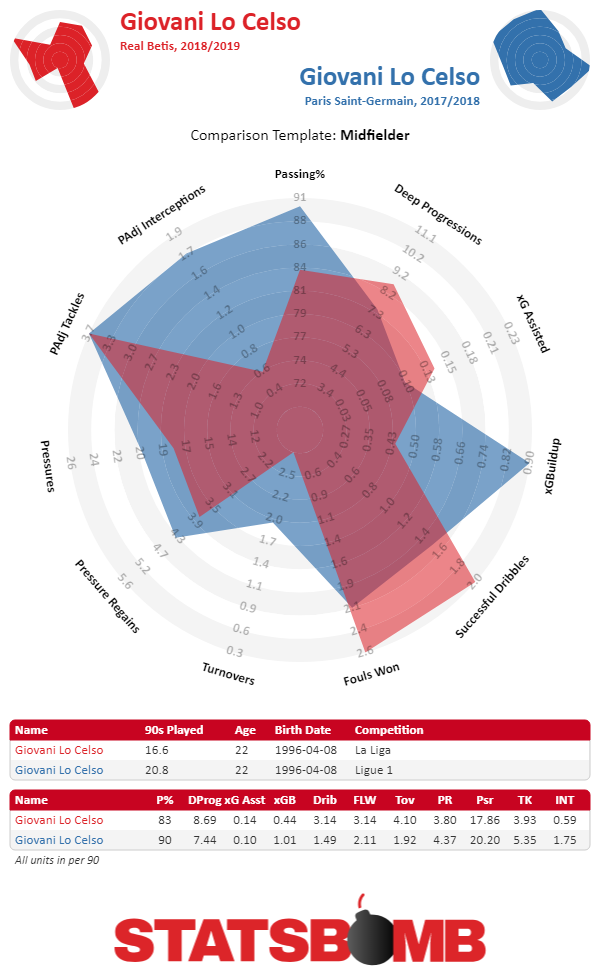
We can see some elements have improved, with more dribbles and higher rates of xG assisted. But big drops in other outputs like xG buildup, passing accuracy, and interceptions. Perhaps this is simply a reflection of a different, more attacking, role with Betis? What about Andre Gomes, he had a torrid season with Barcelona and has been a fan favourite at Everton.
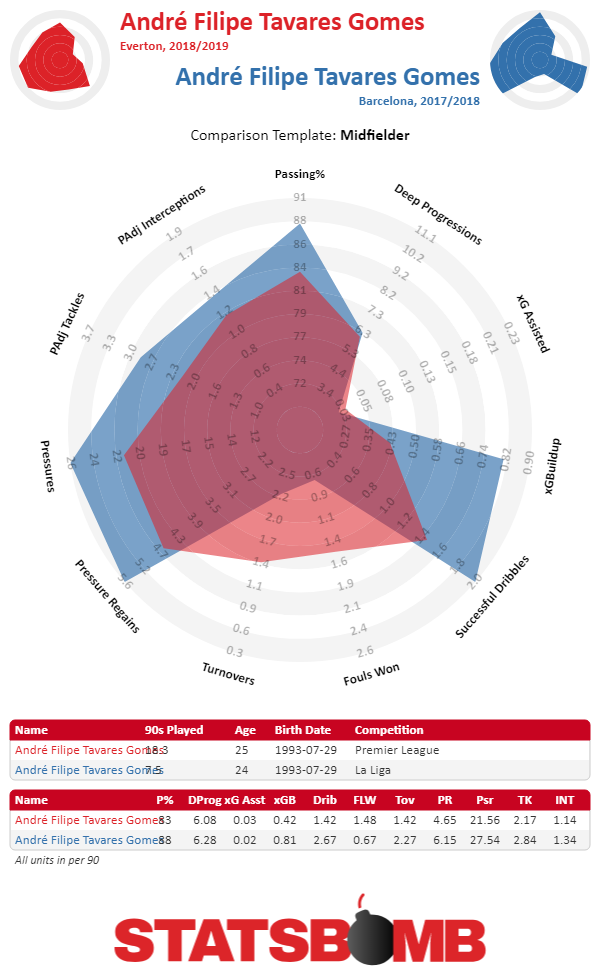
Andre Gomes has dropped in almost all key areas, with fewer pressures, worse passing, and fewer successful dribbles. The same is true of Berchiche and Camarasa. A star player on a poor team is likely to have lower outputs than an unwanted player on a higher level team.
Players who have stayed at the same level
This is our largest group of samples but the most interesting finding is that every player looked at has pretty much maintained their output, as measured on radars. Even those who have moved between leagues.
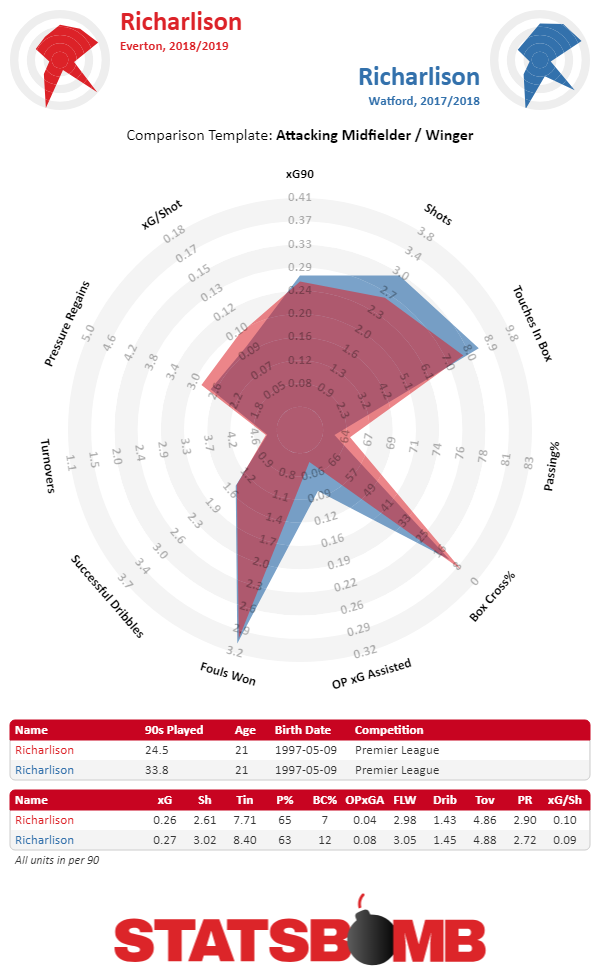
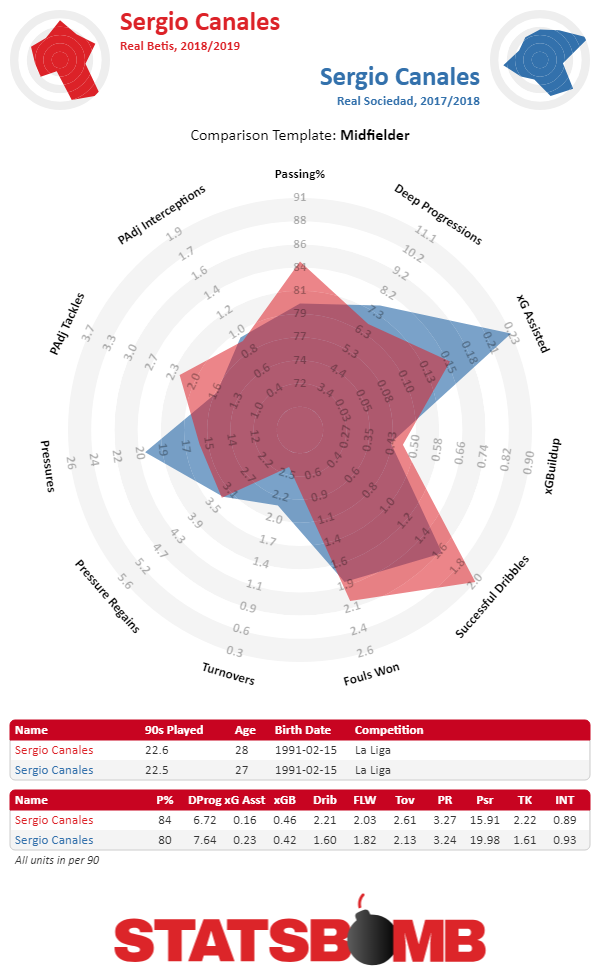
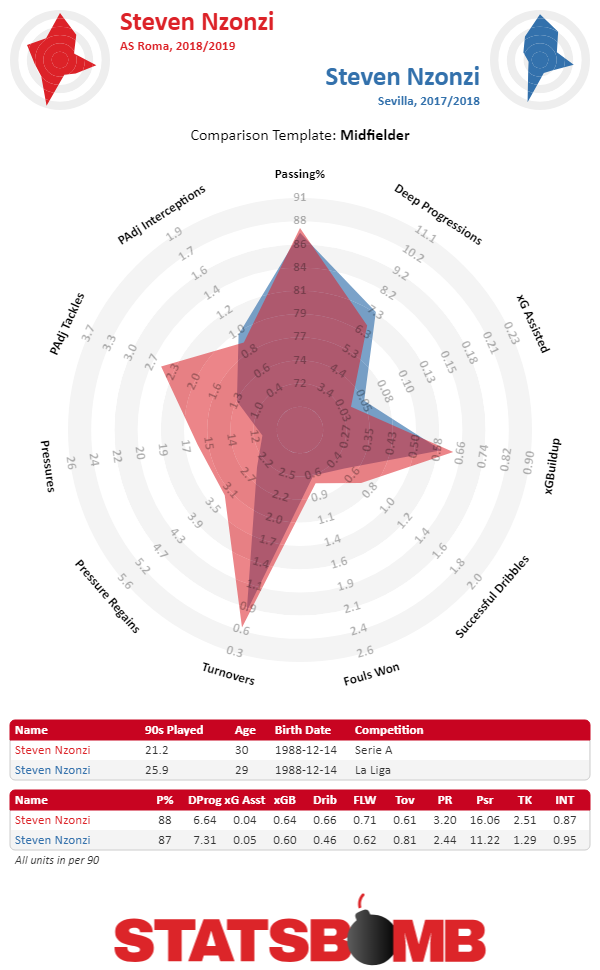
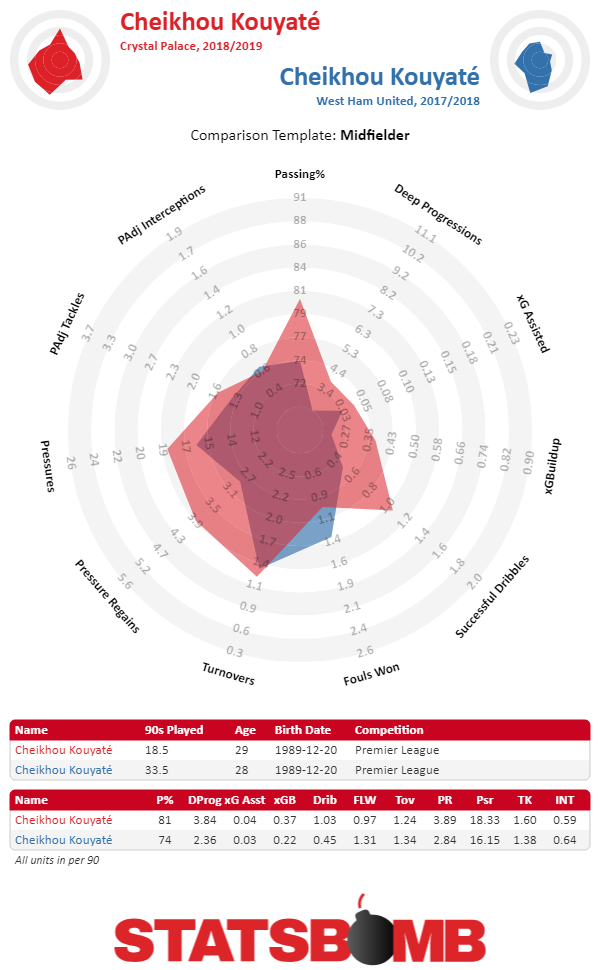
None of the players looked at have a significantly differently shaped radar in 2018/19 compared to 2017/18. They may have slightly changed due to the style of team they are playing in, or their individual form, but overall it looks as though output tends to be replicated when players move between clubs at a similar level.
This isn’t a bad thing, in fact it is a positive sign for scouting players as you can target areas of weakness within your side and be fairly confident that if a player settles into your system they should normally be expected to maintain their output levels.
Players who have moved up a level
When we talk of moving up a level we are normally talking about a midtable player being signed by a Champions League side. And if we look at Fabian Ruiz and Riyad Mahrez we can see that the impact on output is significant. Both players have increased their output significantly by playing alongside better players.
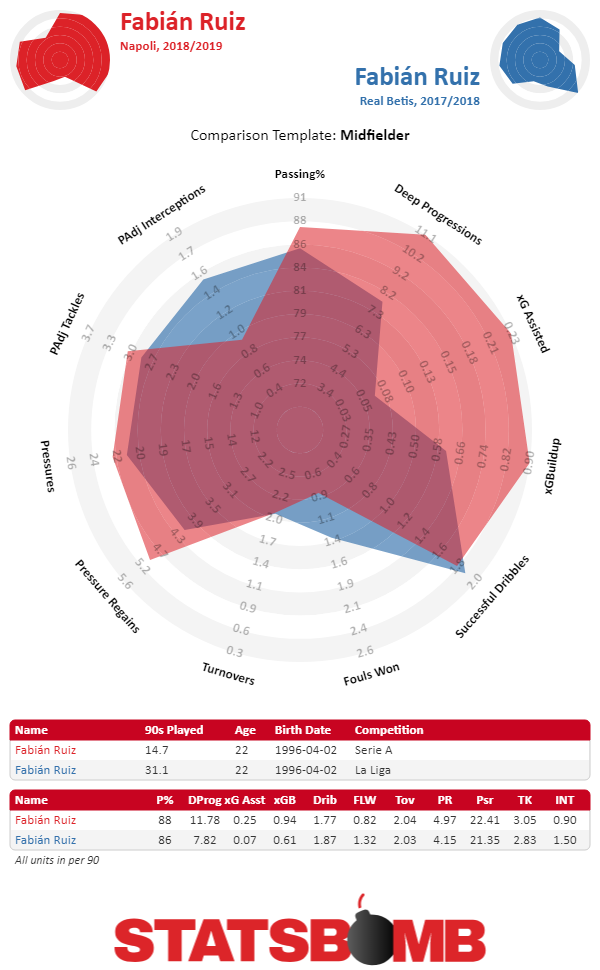
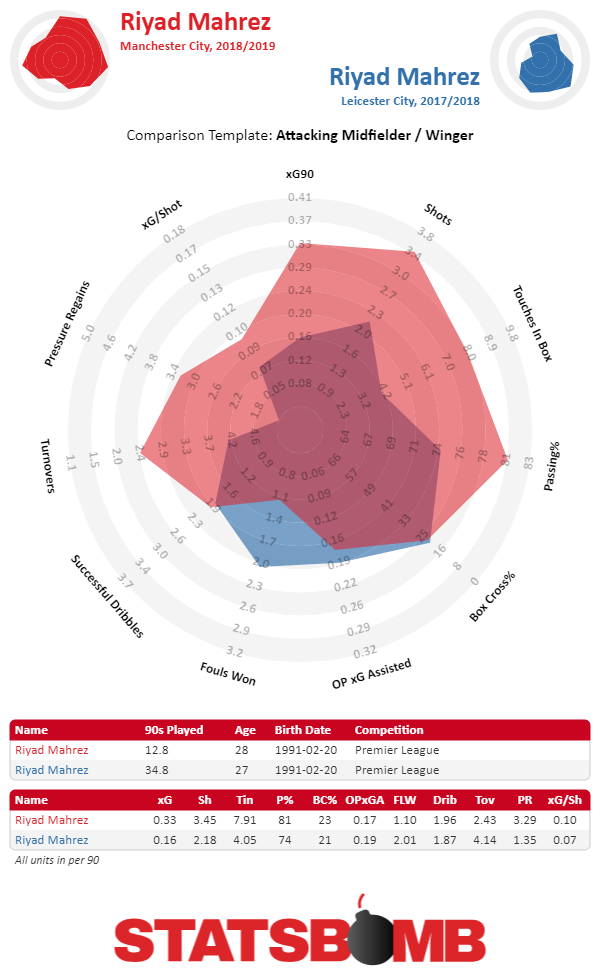
But what if players move up several levels. From a relegation-threatened team to title-chasing team.
Unfortunately, we don’t have many examples of this in the data set.
We do have one though. Xherdan Shaqiri, relegated with Stoke City he now has significant minutes in a Liverpool team chasing the title.
Looking at the 2017/18 radar from his time at Stoke City there is little to suggest a player who could be wearing a league winners medal this May.
But by 2018/19 he has the profile of a good attacking midfielder.
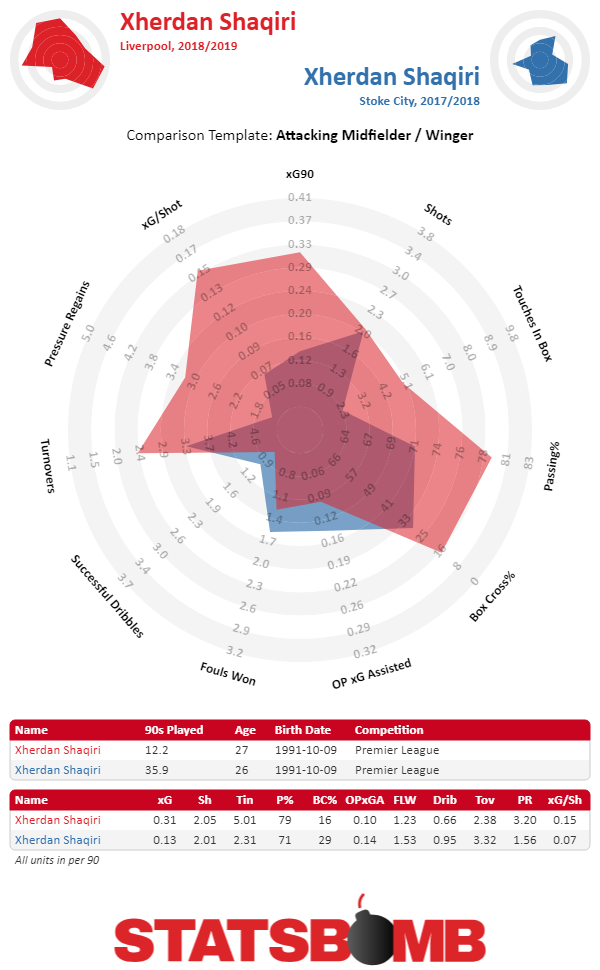
It is fair to say that everyone has known Shaqiri to be a talented player. With Bayern Munich and Inter Milan on his CV, and nearly 80 caps for Switzerland he has simply lacked consistency. Perhaps he is just a case of a player moving back to a level he should be at?
A more surprising move than Shaqiri to Liverpool was former Stoke City teammate Choupo-Moting moving to Paris Saint Germain.
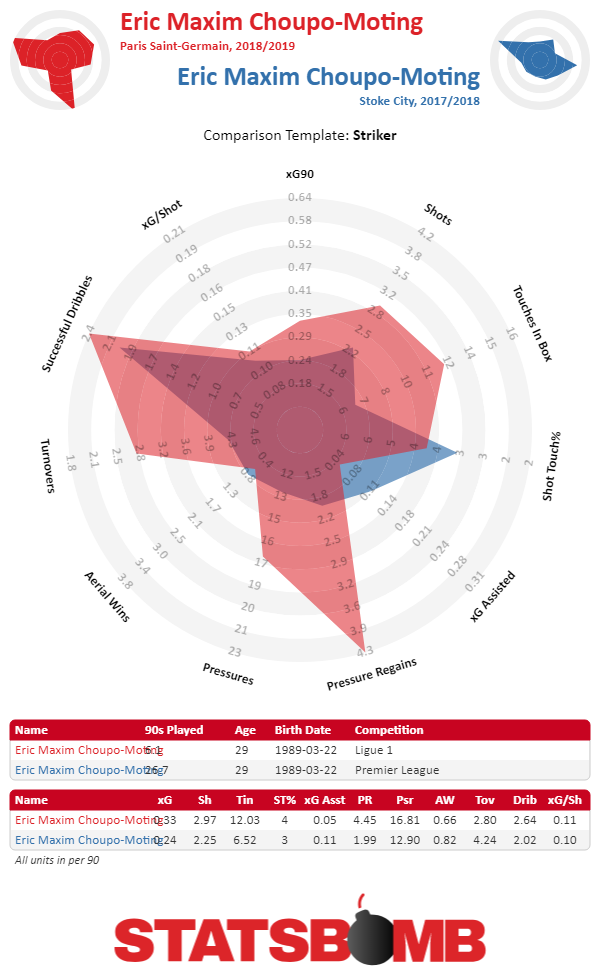
Admittedly the sample size is small as he tends to take the role of a backup striker, but it is clear just how much impact on his output is due to the quality of the supplied passes and the dominance of his team.
This doesn’t mean you can take any random player from a relegated team and put them into a Champions League team and they would be a superstar. But it might suggest that there are plenty of players who would be adequate if surrounded by better players.
Some players going up several levels may even grow into the role and become genuinely good players, like Andrew Robertson who followed relegation with Hull City, to Champion’s League finalist with Liverpool.
The final output test to look at is the impact on relegation on a player’s output as measured by a radar. Team’s who are relegated from the Premier League will play the next season against lower quality opposition. Would we, therefore, expect that their relative ability would be higher. And if you measured that on a radar they would show up as better players.
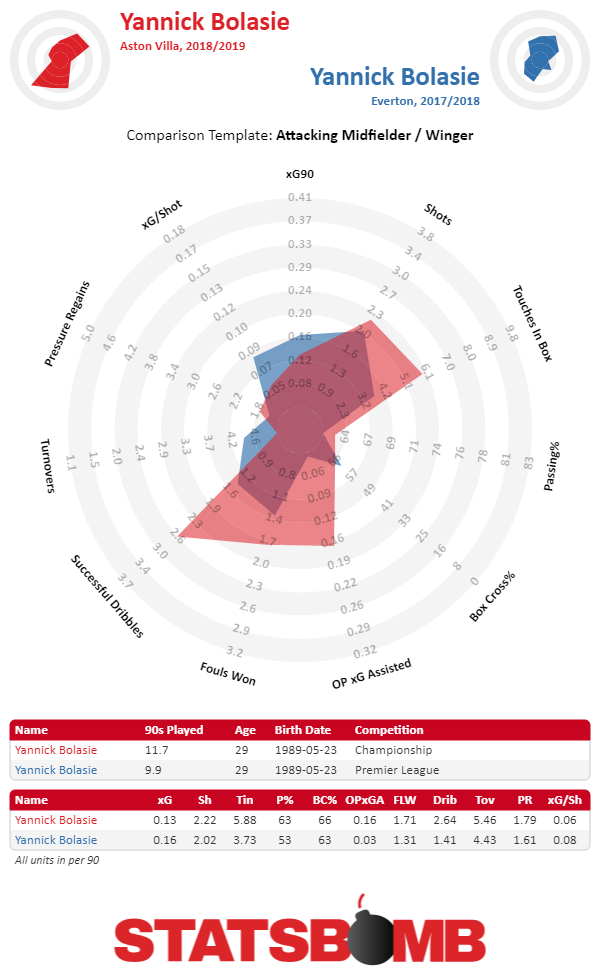
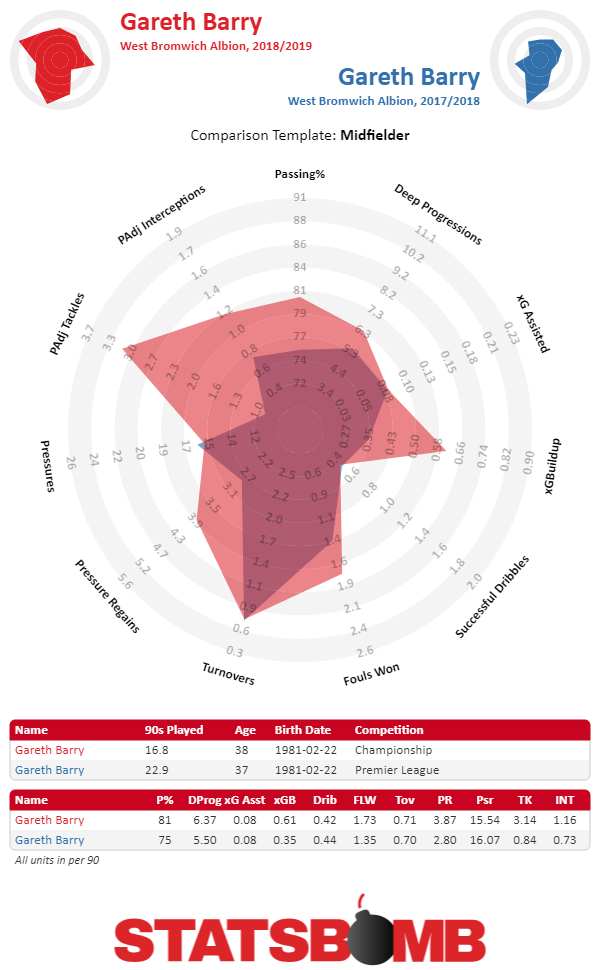

As we can see dropping down a level has maintained the shape of the radar but increased the volume. They are the same players, but their output increases by playing at a lower level and their teammates are no longer worse than average players, but better than average players.
Conversely, we would expect the promoted players radars to shrink in size on promotion as the skill of their teammates relative to the opposition falls.
So what can we conclude?
Players moving to play alongside worse teammates will see a decrease in their output measured on a radar. Players moving to play alongside better teammates will see an increase in their output measured on a radar. This can be very large if moving up several levels. Players transferring between clubs at a similar level will usually maintain their output. Teams playing worse opposition will see individual performances increase. Teams playing better opposition will see individual performances decrease.
The important thing is to look at how relatively dominant the team the player is playing on is. A player with average numbers on a bad team may have higher potential than a player with good numbers on a great team.